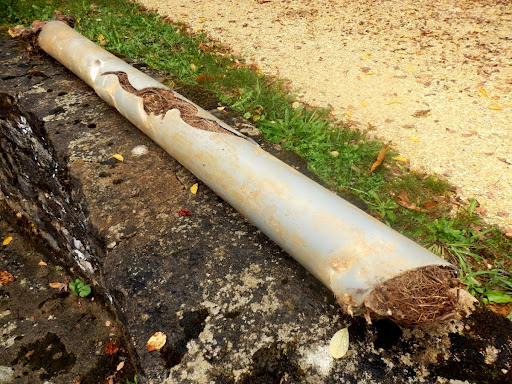That big, shady tree in your backyard probably feels like part of the family. Maybe it's where the kids hung a swing, or it provides that perfect bit of shade during summer cookouts. Trees give character to a property, and they add natural beauty that makes your home feel like, well, home.
But underneath all that charm, those tree roots can create problems you might never see coming. When roots start reaching into your sewer line, things can get messy fast. If you’ve been wondering what’s going on beneath your lawn or why your toilet is acting up, it might be time to think about what those roots are doing underground.
Let’s talk about the signs of tree root invasion in your sewer lines and what you can do about it.
Why Tree Roots Target Your Sewer Line
Roots naturally seek out moisture and nutrients in the soil. If your sewer line has even the smallest crack or loose joint, it becomes a target. The warm, wet conditions inside a pipe make it an ideal spot for root growth. Once the roots sneak in, they expand and trap things like toilet paper and kitchen waste, eventually leading to a blockage.
The danger of tree roots in your sewer line is that they often sneak in quietly. By the time you see a symptom inside your home, the roots could have done a lot of damage outside.
Signs of Tree Root Invasion in Your Sewer Lines
Tree roots inside a sewer line don’t appear overnight. They usually start small and gradually cause more damage. The sooner you notice the signs, the better.
1. Slow-Draining Fixtures Throughout the Home
If you notice that multiple drains in your home are taking longer to clear, it could be more than just a simple clog. A slow-draining kitchen sink might be fixed with a quick clean, but when your bathtub, bathroom sinks, and even your laundry drain are all sluggish, that points to a blockage in the main sewer line. Roots growing inside the pipe can restrict the flow of water and wastewater, creating a bottleneck that affects the entire home.
This issue tends to get worse over time. At first, you may only notice a slight delay when water goes down, but eventually, the standing water can linger for minutes or even hours. If all your drains are acting up at once, it’s worth calling a plumber for a professional inspection.
2. Frequent Toilet Backups
A one-time toilet clog is normal, but if you’re grabbing the plunger several times a week, you could be dealing with more than just an excess of toilet paper. Tree roots in the sewer line block waste from leaving your home properly. Even partial root growth can catch debris like hair, grease, or hygiene products, which leads to repeated blockages.
Over time, the problem escalates. You may have one toilet that clogs more than others, but if the main line is blocked, backups can happen in multiple bathrooms. Consistent clogs are one of the clearest signs of tree root invasion in your sewer lines and should be addressed quickly.
3. Odd Gurgling Sounds
Gurgling noises in sinks, bathtubs, or toilets can indicate a bigger problem. These sounds happen when air gets trapped in the plumbing system, often because something is blocking the flow of water. Tree roots are a common cause, as they create narrow passageways that water must push through.
At first, you might hear these noises only occasionally, such as after a large load of laundry drains or after a shower. As the root blockage grows, the sounds become more frequent and louder. If you hear bubbling or gurgling regularly, it’s time to investigate.
4. Bad Smells Inside or Outside
Sewage smells are one of the most unpleasant plumbing issues a homeowner can deal with. If you detect foul odors in your bathroom, basement, or yard, there’s a chance that roots have cracked your sewer pipe. This allows wastewater to leak into the soil outside or push gases back into your home.
The smell might be faint at first, noticeable only after running the shower or flushing the toilet. Over time, it can become constant and overwhelming. Not only is this unpleasant, but it can also be a health hazard.
5. Wet Spots or Sinkholes in Your Yard
Tree roots that invade sewer lines can cause water to leak into the surrounding soil, leading to wet patches or unusually green areas in your lawn. While this might seem like a small irrigation bonus, it’s a red flag for a broken sewer pipe. That extra moisture can destabilize the soil and create muddy spots, even when it hasn’t rained in days.
In severe cases, you might notice the ground starting to sink or form depressions. These sinkholes can be dangerous, especially if they’re near walkways or driveways.
Why These Signs Shouldn’t Be Ignored
Letting these issues go can lead to much bigger problems. Here's what happens when you ignore the early signs of tree root invasion in your sewer lines:
- Pipes can crack, collapse, or burst from pressure.
- Sewage can back up into your toilet, shower, or basement.
- Water may erode the soil, creating a sinkhole or damaging your foundation.
- Repeated clogs can strain other systems, including your sump pump.
These risks are real, and the danger of tree roots in your sewer line is something many homeowners don’t think about until it’s too late.
How to Know if Tree Roots Are in Sewer Lines
You can spot symptoms, but you won’t know for sure without a professional inspection. A CCTV sewer inspection is the most reliable way to confirm root intrusion.
This involves sending a specialized camera into your pipeline to see exactly what’s causing the blockage. With this technology, you can see the condition of the pipes and the exact location of the problem. That’s valuable because not all plumbing issues are caused by roots; sometimes it’s grease, debris, or a collapsed pipe.
Solutions for Tree Roots Invading Your Sewer Line
Once you’ve confirmed the problem, there are several ways to deal with tree roots invading your sewer line. The right approach depends on the severity of the damage.
- Mechanical Root Removal: A plumber can use a machine with a rotating blade to cut roots out of the pipe.
- Hydro Jetting: This method uses high-pressure water to flush out roots, grease, and sludge.
- Chemical Root Treatments: Foaming root killers can kill the roots inside your sewer line and prevent regrowth for a period of time.
- Pipe Replacement: Replacement may be necessary for severely damaged pipes, replacement may be necessary.
Call G.F. Bowman for Trusted Sewer Line Help
If you're dealing with tree roots invading your sewer line, don't wait until the toilet overflows or your basement smells like a swamp. Early action saves money and stress.
G.F. Bowman has been serving homeowners across south-central Pennsylvania since 1967. Our team shows up on time, treats your home with respect, and gets the job done right the first time. We’re proud to offer services like sewer inspections and drain cleaning in Harrisburg to get to the bottom of stubborn plumbing issues.
Have you spotted any signs of tree root invasion in your sewer lines? Give us a call today!




 1..
1..
 2..
2..
 3..
3..
 4..
4..
 5..
5..
 6..
6..